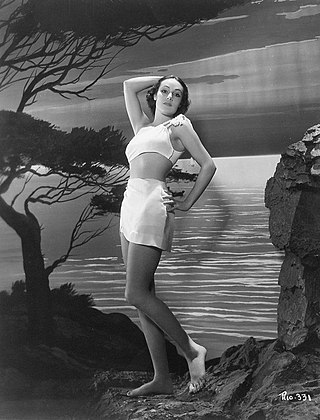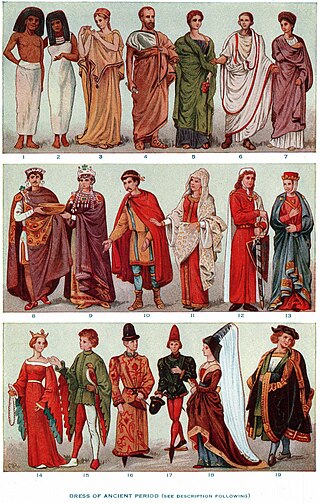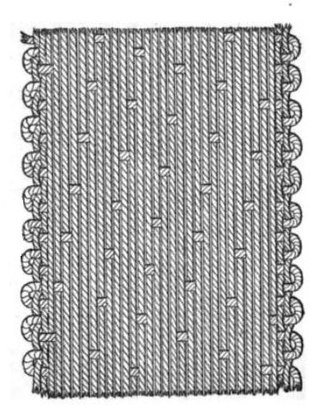Related Research Articles

A bikini is a two-piece swimsuit primarily worn by girls and women that features one piece on top that covers the breasts, and a second piece on the bottom: the front covering the pelvis but usually exposing the navel, and the back generally covering the intergluteal cleft and a little, some, or all of the buttocks. The size of the top and bottom can vary, from bikinis that offer full coverage of the breasts, pelvis, and buttocks, to more revealing designs with a thong or G-string bottom that covers only the mons pubis, but exposes the buttocks, and a top that covers only the areolae. Bikini bottoms covering about half the buttocks may be described as "Brazilian-cut", while those covering about three-quarters of the buttocks may be described as "cheeky" or "cheeky-cut". In May 1946, Parisian fashion designer Jacques Heim released a two-piece swimsuit design that he named the Atome ('Atom') and advertised as "the smallest swimsuit in the world". Like swimsuits of the era, it covered the wearer's belly button, and it failed to attract much attention. Clothing designer Louis Réard introduced his new, smaller design in July. He named the swimsuit after the Bikini Atoll, where the first public test of a nuclear bomb had taken place four days before. His skimpy design was risqué, exposing the wearer's navel and much of her buttocks. No runway model would wear it, so he hired a nude dancer from the Casino de Paris named Micheline Bernardini to model it at a review of swimsuit fashions.

Fashion is a term used interchangeably to describe the creation of clothing, footwear, accessories, cosmetics, and jewellery of different cultural aesthetics and their mix and match into outfits that depict distinctive ways of dressing as signifiers of social status, self-expression, and group belonging. As a multifaceted term, fashion describes an industry, styles, aesthetics, and trends.

Clothing is any item worn on the body. Typically, clothing is made of fabrics or textiles, but over time it has included garments made from animal skin and other thin sheets of materials and natural products found in the environment, put together. The wearing of clothing is mostly restricted to human beings and is a feature of all human societies. The amount and type of clothing worn depends on gender, body type, social factors, and geographic considerations. Garments cover the body, footwear covers the feet, gloves cover the hands, while hats and headgear cover the head, and underwear covers the private parts.
Christian Ernest Dior was a French fashion designer, best known as the founder of one of the world's top fashion houses, Christian Dior SE. His fashion houses are known all around the world, having gained prominence "on five continents in only a decade."

Flappers were a subculture of young Western women in the 1920s who wore short skirts, bobbed their hair, listened to jazz, and flaunted their disdain for what was then considered acceptable behavior. Flappers were seen as brash for wearing excessive makeup, drinking alcohol, smoking cigarettes in public, driving automobiles, treating sex in a casual manner, and otherwise flouting social and sexual norms. As automobiles became more available, flappers gained freedom of movement and privacy.

Retro style is imitative or consciously derivative of lifestyles, trends, or art forms from history, including in music, modes, fashions, or attitudes. In popular culture, the "nostalgia cycle" is typically for the two decades that begin 20–30 years ago.

Preppy is an American subculture associated with the alumni of college-preparatory schools in the Northeastern United States. The term, which is an abbreviation of "preparatory", is used to denote a person seen as characteristic of a student or alumnus of these schools. Characteristics of preppy individuals include a particular subcultural speech, vocabulary, dress, mannerisms and etiquette reflective of an upper class and old money upbringing.

A satin weave is a type of fabric weave that produces a characteristically glossy, smooth or lustrous material, typically with a glossy top surface and a dull back; it is not durable, as it tends to snag. It is one of three fundamental types of textile weaves alongside plain weave and twill weave.

Gabardine is a durable twill worsted wool, a tightly woven fabric originally waterproof and used to make suits, overcoats, trousers, uniforms, windbreakers, outerwear and other garments.

In fashion, an accessory is an item used to contribute, in a secondary manner, to an individual's outfit. Accessories are often chosen to complete an outfit and complement the wearer's look. They have the capacity to further express an individual's identity and personality. Accessories come in different shapes, sizes, hues, etc. The term came into use in the 20th century.

Cleavage is the narrow depression or hollow between the breasts of a woman. The superior portion of cleavage may be accentuated by clothing such as a low-cut neckline that exposes the division, and often the term is used to describe the low neckline itself, instead of the term décolletage. Joseph Breen, head of the U.S. film industry's Production Code Administration, coined the term in its current meaning when evaluating the 1943 film The Outlaw, starring Jane Russell. The term was explained in Time magazine on August 5, 1946. It is most commonly used in the parlance of Western female fashion to refer to necklines that reveal or emphasize décolletage.

A prairie dress or prairie skirt is a modest American style of skirt, an article of women's and girls' clothing.

The old fashioned glass, otherwise known as the rocks glass, whiskey glass, and lowball glass, is a short tumbler used for serving spirits, such as whisky, neat or with ice cubes. It is also normally used to serve certain cocktails, such as the old fashioned. The true old fashioned glass is decorated in the cut glass style, although most modern examples are pressed glass, made using a mold. The design is essentially English, from the late 18th or 19th century. Plain glass versions are lowball glasses.

Fashion design is the art of applying design, aesthetics, clothing construction and natural beauty to clothing and its accessories. It is influenced by culture and different trends, and has varied over time and place. "A fashion designer creates clothing, including dresses, suits, pants, and skirts, and accessories like shoes and handbags, for consumers. He or she can specialize in clothing, accessory, or jewelry design, or may work in more than one of these areas."

A dress is a garment traditionally worn by women or girls consisting of a skirt with an attached bodice. It consists of a top piece that covers the torso and hangs down over the legs. A dress can be any one-piece garment containing a skirt of any length, and can be formal or casual.
Popular culture is generally recognized by members of a society as a set of practices, beliefs, artistic output and objects that are dominant or prevalent in a society at a given point in time. Popular culture also encompasses the activities and feelings produced as a result of interaction with these dominant objects. The primary driving forces behind popular culture, especially when speaking of Western popular cultures, are the media, mass appeal, marketing and capitalism; and it is produced by what philosopher Theodor Adorno refers to as the "culture industry".
American entertainer Jennifer Lopez wore a green Versace silk chiffon dress to the 42nd Grammy Awards ceremony on February 23, 2000. The sheer fabric was printed with a tropical leaf and bamboo pattern, and cut with a very low neckline that extended well past Lopez's navel, while the waist of the dress was studded with citrines.
Gala is a French language weekly celebrity and gossip magazine published in Paris, France. The magazine also has international editions in various languages.

The keffiyeh or kufiyya, also known in Arabic as a ghutrah (غُترَة), shemagh, or ḥaṭṭah (حَطَّة), is a traditional headdress worn by men from parts of the Middle East.
Prostitution, as defined under modern Japanese law, is the illegal practice of sexual intercourse with an 'unspecified' (unacquainted) person in exchange for monetary compensation, which was criminalised in 1956 by the introduction of article 3 of the Anti-Prostitution Law. However, the definition of prostitution made illegal under this law is strictly limited to sexual intercourse with an 'unspecified person', and does not criminalise the sale of numerous other acts performed by sex workers in exchange for compensation, such as oral sex, anal sex, mammary intercourse, and other non-coital sex acts; the Businesses Affecting Public Morals Regulation Law of 1948, also known as the "Law to Regulate Adult Entertainment Businesses", amended in 1985, 1999 and 2005, regulates these businesses, making only one definition of prostitution in Japan illegal.
References
- ↑ Sumathi, G. J. (2007). Elements of Fashion and Apparel Design. New Age International. p. 88. ISBN 978-8122413717.
- ↑ Lewandowski, Elizabeth J. (2011). The Complete Costume Dictionary. Scarecrow Press. p. 224. ISBN 978-0-8108-4004-1.